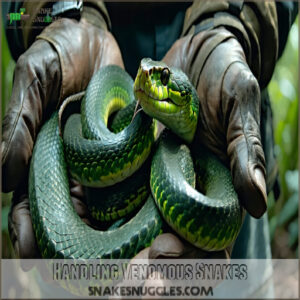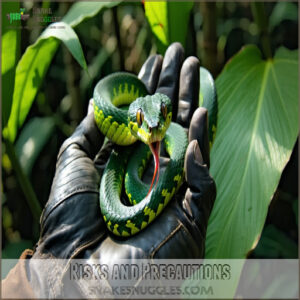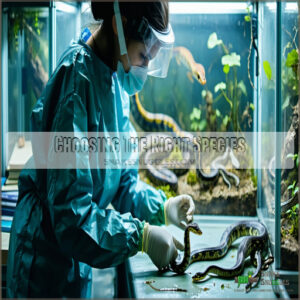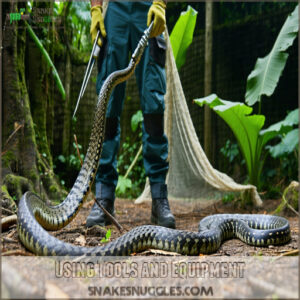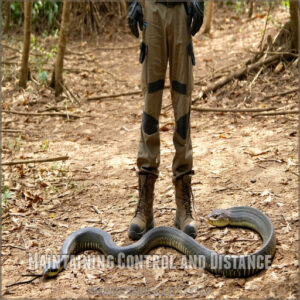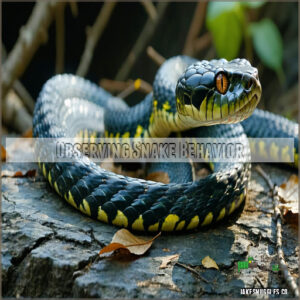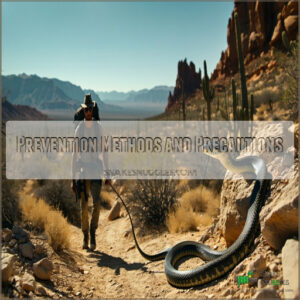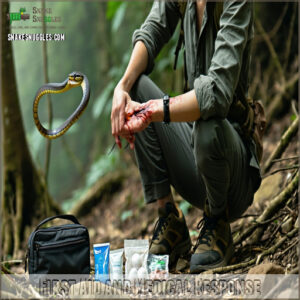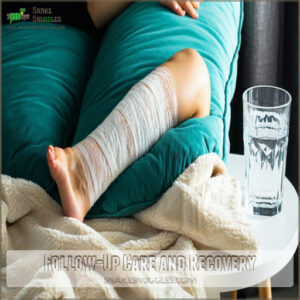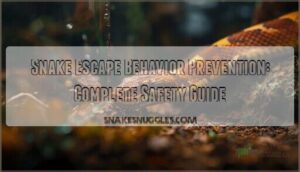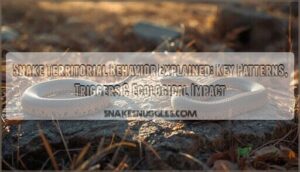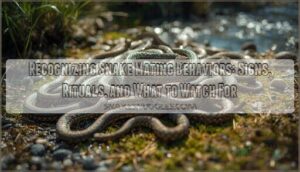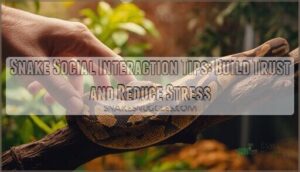This site is supported by our readers. We may earn a commission, at no cost to you, if you purchase through links.
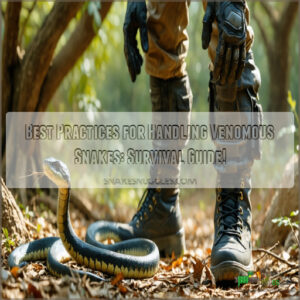
First, gear up with puncture-resistant gloves, snake-proof pants, and sturdy boots – your armor against potential strikes.
Learn to read snake body language like a pro, spotting those telltale signs of aggression: triangular heads, elliptical pupils, and defensive postures.
Move slowly, avoid sudden movements, and never handle a snake without proper training.
Always keep a safe distance, respect their lightning-fast reflexes, and have an emergency plan with antivenom information on speed dial.
Remember, one wrong move could turn a thrilling encounter into a life-threatening nightmare.
Table Of Contents
- Key Takeaways
- Handling Venomous Snakes
- Risks and Precautions
- Choosing The Right Species
- Legal Considerations
- Safe Handling Techniques
- Preventing and Treating Bites
- Frequently Asked Questions (FAQs)
- How to handle venomous snakes safely?
- How do you handle snakes?
- How do you protect a snake during humane capture?
- How do you approach a venomous snake?
- How to master snake handling techniques?
- How do you prevent a snake bite?
- How to properly handle a venomous snake?
- What are 3 things you should do if you are bitten by a venomous snake?
- What are tips for handling snakes?
- Where to grab a venomous snake?
- Conclusion
Key Takeaways
- You’ll need specialized protective gear like puncture-resistant gloves, snake-proof pants, and sturdy boots to minimize risks when handling venomous snakes – your clothing is your first line of defense.
- You must master reading snake body language, recognizing defensive postures like S-shaped coiling, raised heads, and rapid tongue flicking to predict and avoid potential strikes.
- You can’t handle venomous snakes without proper professional training, specialized tools like snake hooks, and a rock-solid emergency response plan with immediate medical contact information.
- You’ll want to prioritize maintaining a safe distance, moving slowly, and never provoking or cornering a snake – one wrong move could turn a controlled encounter into a life-threatening situation.
Handling Venomous Snakes
If you’re thinking about handling venomous snakes, you’ll need nerves of steel and a brain full of caution.
Your survival depends on understanding these deadly creatures’ behavior, mastering precise handling techniques, and respecting their potential to strike with lightning speed.
This is the core of what you need to know to handle such dangerous animals safely.
Safety Equipment and Clothing
Ever wondered how to dress for a date with danger?
Safety starts with the right protective gear when handling venomous snakes.
Your life literally depends on it.
Consult a thorough snake handling safety equipment list for a complete overview of essential gear.
- Snake handling gloves made of puncture-resistant leather
- Thick, long-sleeved shirts and snake-proof pants
- Sturdy over-the-ankle boots with protective materials
Suit up like a pro: face shields, safety equipment that doesn’t compromise, and clothing that screams "I’ve got this!
Emergency Preparedness and Response
After suiting up in protective gear, your next move is building a rock-solid emergency response plan.
Pack a thorough first aid kit with snake bite protocol essentials: clean bandages, antiseptic wipes, emergency contact numbers, and medical information.
Know your local hospital’s antivenom capabilities.
Practice calm crisis management—panicking can worsen snake bite symptoms and complicate emergency response.
When dealing with venomous snakes, it’s vital to follow proper snake handling techniques to minimize risks and guarantee a safe encounter.
Identifying Venomous Snake Species
After prepping for emergencies, knowing your slithery opponents is key.
Spot venomous snakes by their triangular heads, elliptical pupils, and distinctive fang features.
Look for unique snake scale patterns and body language cues.
Rattlesnakes, cobras, and vipers have telltale signs like neck hoods or tail rattles.
Remember, species identification isn’t just science—it’s your survival ticket.
Risks and Precautions
When handling venomous snakes, you’re stepping into a world where one wrong move could mean life or death, so understanding the risks isn’t just smart—it’s survival.
Your knowledge of defensive postures, bite consequences, and prevention techniques can mean the difference between a close call and a fatal encounter.
Potential Consequences of Bites
Because venomous snake bites can trigger life-altering consequences, understanding venom effects is essential.
Snake toxins may cause paralysis, bleeding disorders, and kidney failure.
Serious bite reactions range from tissue damage to potential fatality.
Emergency response matters: immediate medical treatment can prevent long-term complications like amputation or chronic health issues, and it is crucial to get help fast.
Stay alert.
Recognizing Defensive Postures
Decoding snake body language can mean the difference between a safe encounter and a dangerous bite.
Understanding venomous signals is essential for survival.
Watch for these key defensive postures:
- S-shaped coiling ready to strike
- Raised head and neck positioning
- Rapid tongue flicking warning
- Tail rattling (especially in rattlesnakes)
- Bulging venom glands indicating aggression
Recognizing these aggressive postures helps you stay one step ahead of potential attacks, which is crucial for survival.
Avoiding Provocation and Attacks
Any wrong move could turn a snake encounter into a dangerous game.
Understanding snake body language is your lifeline when avoiding attacks.
For additional safety tips, review this guide on how to avoid a snake.
Watch for defensive postures like coiling, raised heads, and rapid tongue flicking.
Stay calm, move slowly, and never provoke or corner a venomous snake.
Safety protocols demand respect, distance, and keen observation of venomous behavior.
Choosing The Right Species
When you’re ready to start handling venomous snakes, you’ll need to choose a species that matches your experience level and safety capabilities.
Understanding each snake’s unique characteristics, temperament, and handling requirements will help you make a smart, informed decision that keeps both you and the snake safe, considering their unique characteristics.
Native Vs Exotic Species
When exploring snake species, understanding the difference between native and exotic can save your skin.
Your choice impacts more than just your collection—it affects local ecosystems and wildlife conservation.
Here’s what you need to know:
- Native species adapt perfectly to local environments
- Exotic snakes can disrupt delicate ecological balances
- Conservation efforts depend on responsible species selection
- Local regulations vary dramatically by region
Choose wisely, snake enthusiast.
Beginner-Friendly Options
When entering the sphere of venomous snake handling, beginners need a strategic approach to choose snake species wisely.
For new snake owners, understanding best snake species for beginners is essential before handling venomous snakes.
Here’s a quick guide to help you pick beginner-friendly options:
| Species | Temperament | Handling Difficulty |
|---|---|---|
| Ball Python | Calm | Easy |
| Corn Snake | Docile | Moderate |
| Kingsnake | Predictable | Moderate |
| Rosy Boa | Gentle | Easy |
Master gentle snake handling techniques and prioritize safety above all.
Understanding Snake Characteristics
So you’re ready to level up your snake smarts after exploring beginner-friendly options.
Understanding snake characteristics is your golden ticket to safe handling.
- Snake body language speaks volumes about their mood and intent
- Fang structure reveals potential venom delivery mechanics
- Snake scales provide critical identification clues
- Unique visual capabilities help predict snake behavior
Knowing these markers can mean the difference between a calm encounter and a dangerous surprise, which is why understanding safe handling is crucial.
Legal Considerations
Before you commence your venomous snake handling journey, you’ll need to understand the complex legal landscape that governs these potentially dangerous creatures.
Each state and local jurisdiction has unique regulations, permit requirements, and restrictions that you must carefully research and comply with to verify you’re operating within the law.
You must ensure that you are well-informed about these regulations to handle snakes safely and legally.
State and Local Laws
After exploring snake species, you’ll want to understand the legal landscape of venomous snake ownership.
State laws vary wildly – some welcome snake enthusiasts with open arms, while others slam the door shut.
Law enforcement takes regulatory compliance seriously, with potential fines lurking for those who ignore jurisdiction limits.
Understanding state laws regulations is vital for mastering the complex world of venomous snake ownership.
Your responsible ownership depends on knowing these legal considerations inside and out.
Permit Requirements
A snake handler’s legal journey starts with understanding permit requirements.
Traversing the complex world of venomous snake ownership demands careful attention to local regulations.
- Check state-specific permit mandates
- Prepare documentation carefully
- Understand experience requirements
- Budget for potential permit fees
Regulatory compliance isn’t just paperwork—it’s your ticket to responsible, legal snake handling.
Government regulations protect both handlers and communities, ensuring you’re prepared before bringing a venomous reptile home, which is key to responsible and safe practices.
Finding a Mentor
When traversing the wild world of venomous snake handling, finding the right mentor can be your lifeline.
Check out these key qualities to seek in experienced trainers:
| Mentor Quality | Essential Skills |
|---|---|
| Expertise | Proven snake handling techniques |
| Safety Record | Documented responsible practices |
| Teaching Style | Clear, patient instruction |
Let an expert guide you through the intricate dance of venomous snake handling with a clear, patient instruction.
Ethical Considerations
Respect for life pulses at the heart of ethical snake ownership.
You’re not just handling a reptile; you’re stewarding a critical part of our ecosystem.
Prioritize animal welfare by understanding each species’ unique needs, habitat requirements, and behavioral patterns.
Responsible ownership means balancing conservation efforts with community safety, ensuring humane treatment that protects both the snake and those around you.
Safe Handling Techniques
If you’re venturing into snake handling, you’ll need nerves of steel and a toolbox of critical skills to stay safe.
Mastering the art of controlled, deliberate movements and using specialized equipment like snake hooks can mean the difference between a successful interaction and a potentially life-threatening encounter.
Using Tools and Equipment
When working with venomous reptiles, the right tools can be your best defense.
Your legal compliance now transforms into practical safety with specialized snake handling equipment.
Master your gear before mastering the snake.
- Snake hooks for precise, hands-free control
- Handling tongs to maintain safe distance
- Puncture-resistant snake-proof gloves
- Safety nets for emergency containment
These tools aren’t just accessories—they’re lifelines between you and potential danger.
Effective snake handling also involves understanding the proper use of snake hook devices to guarantee safe and controlled interactions with venomous species.
Maintaining Control and Distance
After mastering your tools, maintaining precise control and distance becomes your lifeline.
Keep at least six feet between you and the snake, moving with calculated, slow steps.
Your snake handling gloves and space awareness are your best defense.
Stay alert, predict potential defensive postures, and remember: one wrong move can turn a careful encounter into a dangerous dance.
Observing Snake Behavior
Tune into a snake’s body language like a wildlife detective.
Recognize defensive postures such as S-shaped coiling or raised heads as critical Venomous Snake Alerts.
Watch for stress signs—rapid tongue flicking, trembling, or color changes signal potential aggression.
Your keen observation of behavioral warning signs can mean the difference between safety and a dangerous encounter.
Preventing and Treating Bites
Regarding venomous snake bites, your quick thinking and preparation can mean the difference between life and death.
You’ll want to master prevention techniques, recognize critical symptoms, and know exactly how to respond in those heart-pounding moments when every second counts.
Prevention Methods and Precautions
A steel-tipped snake hook can be your best friend when traversing venomous snake safety protocols.
Always prepare emergency kits with essentials like antivenom contacts and first aid supplies before encountering snake habitats.
Understand snake behavior, recognize defensive postures, and maintain calm.
Implement hazard control strategies that prioritize distance, awareness, and calculated movements to minimize potential venomous snake encounters.
Effective snake handling often requires the use of a snake hook tool to safely capture and relocate venomous species.
Recognizing Bite Symptoms
Those telltale fang marks aren’t the whole story regarding snake bite symptoms.
Watch for intense pain, rapid swelling, and discoloration around the wound site.
Venom effects can trigger serious toxic reactions, including dizziness, nausea, and difficulty breathing.
Blood-red flags like sweating, weakness, and muscle twitches signal an urgent medical emergency with venomous snake bites.
In such cases, it’s crucial to recognize the signs of a severe reaction, as they can quickly escalate into a life-threatening situation, characterized by serious toxic reactions.
First Aid and Medical Response
A venomous snake bite triggers an immediate, high-stakes medical emergency.
Your calm and calculated response can make the difference between life and death.
While this article focuses on venomous snakes, non-venomous bites can also cause injury, so understanding boa constrictor bite prevention is still valuable.
Stay calm and call emergency services immediately, remove tight clothing and jewelry near the bite, and keep the bite area below heart level.
Clean the wound with soap and water, without incisions, to ensure proper care for the medical emergency.
Follow-Up Care and Recovery
After battling a snake bite, your recovery journey begins.
Medical aftercare is key to healing.
Here’s a snapshot of your post-bite recovery path:
| Recovery Stage | Timeline | Action Items |
|---|---|---|
| Immediate | 24-48 hrs | Hospital monitoring |
| Short-term | Weeks | Pain management |
| Long-term | Months | Wound healing therapy |
Stay patient, follow your doctor’s guidance, and prioritize rest during post-bite therapy.
Frequently Asked Questions (FAQs)
How to handle venomous snakes safely?
Think handling venomous snakes is a walk in the park? Don’t kid yourself.
Use snake hooks, wear puncture-proof gloves, move slowly, and keep a safe distance.
Never handle alone, and always prioritize professional training and safety first.
How do you handle snakes?
When handling snakes, stay calm, move slowly, and use specialized tools like snake hooks.
Wear protective gear, maintain a safe distance, and never handle them without proper training.
Respect their space and avoid sudden movements, using specialized tools to ensure safety.
How do you protect a snake during humane capture?
Use gentle snake hooks to guide the snake into a sturdy, well-ventilated bag.
Wear protective gear, move slowly, and keep the snake calm.
Always prioritize both your safety and the snake’s well-being during capture.
How do you approach a venomous snake?
Keep your cool and tread lightly when a venomous snake‘s in your path.
Maintain a safe distance, move slowly, and avoid sudden movements.
Never provoke or attempt to handle it without professional training and proper equipment.
How to master snake handling techniques?
Master snake handling through intensive training, protective gear, and calm confidence.
Learn from experts, practice controlled techniques, and respect each snake’s unique temperament.
Always prioritize safety with specialized tools and a steady, deliberate approach.
How do you prevent a snake bite?
Ever stepped on a surprise snake?
Stay alert, wear protective boots and long pants, learn snake body language, and keep a safe distance—your quick wit and caution are your best snake-bite shield.
How to properly handle a venomous snake?
Want to handle a venomous snake?
Never do it without expert training.
Always use snake hooks, wear protective gear, and move slowly.
Stay calm, control the snake’s head, and have an emergency plan ready.
What are 3 things you should do if you are bitten by a venomous snake?
When the serpent’s fangs strike like lightning, stay calm.
Call 911 immediately, keep the bite below heart level, and avoid moving.
Remove tight clothing, and let professionals handle the venom’s silent, deadly dance.
What are tips for handling snakes?
You’ll need snake hooks, puncture-resistant gloves, and steady nerves.
Move slowly, stay calm, and never grab a snake’s head.
Always have backup, use proper tools, and respect the snake’s space.
Where to grab a venomous snake?
Got bitten, and you’re in a snake’s crosshairs?
Never grab a venomous snake, Period.
Use snake hooks or tongs to control the head from a safe distance.
Your life’s worth more than a risky grab.
Conclusion
Ultimately, mastering best practices for handling venomous snakes requires respect, knowledge, and unwavering caution.
You’ll need more than courage—you’ll need scientific precision and situational awareness.
Whether you’re a professional or curious amateur, never underestimate a snake’s potential danger.
Stay informed, prepare thoroughly, and prioritize safety above all else.
By understanding snake behavior, using proper equipment, and maintaining a cautious approach, you’ll minimize risks and transform potentially life-threatening encounters into manageable, calculated experiences.
- https://nt.gov.au/environment/animals/keeping-wildlife-as-pets/keeping-snakes/handling-venomous-snakes
- https://reptilesupershow.com/snake-handling-safety-tips-for-secure-encounters/
- https://lucec.loyno.edu/handling-snakes-safely
- https://www.sciencedirect.com/science/article/abs/pii/S1557506308001316
- https://ufwildlife.ifas.ufl.edu/safely_dealing_with_snakes.shtml

